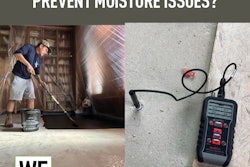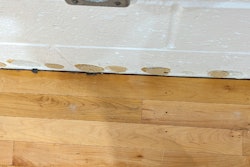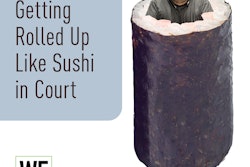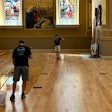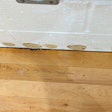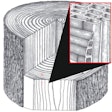
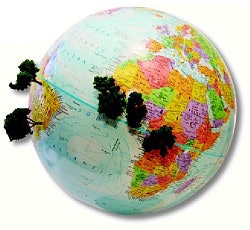
It seems nearly every day someone mentions a wood flooring species even the most astute people in the industry haven't heard of. Manufacturers travel into the far reaches of the globes' forests to find a floor that no one else has, while high-end clients compete to own a floor unlike the others in the neighborhood.
You may be one of a handful of wood flooring contractors in cutting-edge design markets who are experts at handling species from Africa to southeast Asia. You may casually toss around exotic names in conversation as if the trees grew next door. More likely, however, you are the average wood flooring contractor, just starting to think about taking on an exotic job. Maybe you're trying to capture a more profitable segment of the market, or maybe one of your customers saw it on the Internet and asked for it. Either way, handling exotics is probably a smart business move, but there's a lot to learn besides how to say the unusual names. Following are 10 common mistakes the average contractor makes when taking on the world of imported wood flooring and how to avoid them.
Mistake #1: Buying From an Unknown Source
Horror stories abound about contractors who bought their exotic flooring through an unknown supplier. Once they received it, they may have found that the grade wasn't what they were promised, the wood wasn't properly kiln dried or the milling was poor. In other cases, contractors have been sold wood that wasn't even the species they thought it was. Then, when they use their usual sanding and finishing procedures for that species, the floor fails.
As with anything else, buy from a supplier you trust. Suppliers should be able to inform you of what to anticipate with the color change, installation, sanding and finishing of that species. If they can't, that's a good clue that you should buy somewhere else.
Mistake #2: Moisture Messes
Many exotics are extremely reactive to changes in moisture, demonstrating substantial expansion and contraction. Of course, this makes job-site acclimation more important than ever. Readings should be taken of temperature, relative humidity, the subfloor moisture content and the flooring moisture content, and the flooring should be installed at the average levels for the entire year. So, if it's a hot, humid summer in Minneapolis, you need to shoot for the average readings between the hot summer and the area's cold, dry winter.
Using a moisture meter is important, but you must make sure the readings are valid. Most moisture meters are calibrated for testing the moisture content of Douglas fir or oak. Many exotics have different electrical properties, meaning that a reading on such a moisture meter may be several percentage points off, possibly resulting in a jobsite disaster. Talk to your exotic wood flooring supplier and your moisture meter manufacturer to learn how to get an accurate reading for the specific species you plan to use. In general, installers experienced with many exotics recommend planning on extended acclimation times, from weeks to months, to safely acclimate the wood.
Mistake #3: Toxic Reactions
Some people have no allergic reaction at all when working with exotic species, while in extreme cases others have ended up in the hospital with severe respiratory or dermatological reactions to certain exotic species. Dust particles can cause respiratory problems such as difficulty breathing, while contact with the wood may result in bad rashes. This sensitivity may increase with exposure to the wood over time, so installers who never have had a problem with a particular species may suddenly react to the wood.
Some species have little allergic reaction potential, while others, such as padauk, teak, wenge and ipé (Brazilian walnut) are among the many species that commonly cause adverse reactions. Before installing or sanding a new species, it's a good idea to do a skin patch test—apply a small amount of the wood dust with a Band-Aid to the inside of your arm for 24 hours. Wearing long sleeves and covering as much skin as possible when cutting or sanding the species may help prevent reactions. To help avoid respiratory reactions, wear a respirator.
Mistake #4: Underestimating Hardness
Many exotic species are much harder than the woods most installers commonly use. Installers unprepared for this may find that nailing the floor is a problem, with nails not setting correctly or breaking the tongues on the flooring. Experimenting with slight adjustments to the nailing angle (by, for example, applying a small amount of tape onto the bottom of the nailer plate) and/or adjusting the pressure on the compressor usually solves these problems. With the hardest species, such as ebony, predrilling is usually required. While nailing, installers also may find that it's more difficult to straighten out crooked boards than it would be with an oak floor, making it all the more important to buy from a supplier with quality milling. The hardness also means that all saw blades should be sharp and changed frequently.
Once they get to sanding the floor, contractors accustomed to working with a red oak floor may find they're in for a different challenge. When using finer grits, the wood's hardness may cause the floor to burnish, with some species actually burning and turning dark. Burnishing also can cause finish adhesion problems. To avoid this, experiment with the sanding sequence on a test panel before doing a real floor, and avoid using too fine a grit as your final cut on certain species.
On the other hand, with extremely dark species, contractors may find they have to sand to a finer grit than they normally would to hide the scratch pattern from the buffer. In these cases, make sure the final sanding won't cause the problems described in the previous paragraph. Some contractors avoid buffing altogether with certain species because of problems hiding the scratch.
When working with Australian cypress, contractors have found that the knots are extremely hard, so care must be taken when sanding that species to prevent the sander from dishing out the wood surrounding the knots.
As with every floor, when working with hard exotic species, make sure you start with the least aggressive abrasive necessary—if you don't put a deep scratch in, you don't have to take it out.
Mistake #5: Poor Dust Management
Good dust control should be part of every wood flooring job, but it's crucial when working with exotics, for several reasons. First, the dust of some exotics, such as padauk and purpleheart, tends to stain fabrics and wallcoverings. Installers also report that dust from ipé can even leach into paint if left to sit overnight.
Cleaning as much dust as possible from the floor after sanding also is vitally important. The dark colors of many exotic species tend to make applicator marks more visible, and they are exaggerated when the applicator picks up any fine wood dust left on the floor. Vacuuming the floor with a brush head on a professional-grade vacuum, dry tacking with a clean cloth and vacuuming again with a felt head to pick up any residual dust and cloth fibers are good practices to help prevent problems.
Mistake #6: Not Testing Finish Compatibility
Many imported species, from ipé (Brazilian walnut) to tigerwood, are oily woods. Some species have so much resin that if you look closely after just a few minutes of sanding, you will see small spots of oil that have worked their way up to the surface of the wood. With knotty species, such as Australian cypress, you may notice oil migrating up in the knots. When left for too long, these spots can cause problems with both finish adhesion and dry times.
To combat the problem with adhesion, experts recommend finishing the floor as soon as it is sanded, before the natural resins have a chance to migrate back up to the surface. Some contractors attempt to eliminate this problem by tacking the floor with a solvent such as virgin mineral spirits or denatured alcohol before coating, but that practice is not recommended by finish manufacturers, who believe this may contaminate the floor or may bring up even more resins in the wood.
Many contractors also find that waterborne finishes work best with some imported woods. Some contractors report waiting as long as a week or more for oil-modified finish to dry over certain exotic species. In some cases, the finish never fully cures, causing early wear problems and poor adhesion. Some contractors find that coating the floor with penetrating oil and/or wax is a good option.
An additional complication with finishing is that the minerals such as silica in some exotic species may cause reactions with the finish, resulting in strange color changes. To help prevent all of these problems, it's a good idea to test the species with the sanding technique and the finish you plan to use on the job site.
Finally, once you find methods that work for a certain species, don't assume they will work every time, especially if you change suppliers. Some exotic woods' characteristics, such as resin content, may vary widely depending on the region where the tree was grown, even if it's the same species.
Mistake #7: Staining Exotics
Keep in mind that many exotic species don't take stain well. The stain may have problems drying, and it may have a blotchy appearance, similar to stained domestic maple. If you do stain, don't be too generous with the stain application, as the stain can seep into the seams between boards and interact with the oils or resins in the wood, causing drying problems at the seams. Again, test the product you intend to use for dry time and appearance before using it on a real floor.
Many contractors don't even consider staining exotic species, not because of technical problems, but because the customer is usually paying more for an unusual wood. Instead of trying to stain the wood a different color, a different exotic species that is naturally the desired color may be the answer.
Mistake #8: Not Anticipating Color Change
Nearly all woods change color to some degree with exposure to light and air, but many exotics tend to experience a greater color change than most contractors may be accustomed to. Some species darken; some lighten. Either way, both the contractor and the customer should be aware of this. Savvy contractors have samples available for their customers showing both what the wood looks like freshly cut and what it looks like after being aged. This can help prevent customers going into a panic the first time they see their brand new Brazilian cherry floor that doesn't look anything like the sample they chose in the showroom, or calling with a complaint when they rearrange their furniture a year later.
While the customer needs to anticipate a color change, the contractor also needs to keep it in mind when filling the floor. Any filler used on the floor should match the color of the floor as it ages. To that end, some contractors mix their own filler using the wood dust of that species.
The contractor also needs to educate the builder about the possibility for color change. If the floor is covered to protect it from other trades, the covering must extend wall to wall to avoid a two-toned floor.
With some exotic species, differences in color change blend in over time. Be aware, however, that with other exotic species, the difference in color seems nearly permanent if the floor is not resanded.
Mistake #9: Not Educating the Customer
Color change isn't the only thing to discuss with the customer. When selecting the floor, it's important to make sure the customer has seen a large enough selection of the flooring to see the variations in color and character marks. A small sample block may not give an accurate representation of what an entire room of the wood will look like, including character marks and the full range of color variation. Photos in your portfolio or from the manufacturer showing entire room scenes of the species and grades being considered are particularly helpful. Also, make sure the customer is aware of how the wood will look with the specific finish chosen. Many exotics take on a substantially different appearance depending on the type of finish.
Also, make sure the customer understands the potential for movement in her exotic floor, which may be more extreme than the gaps in the floor she grew up with. As with any floor, managing the customer's expectations may be the most important key to a successful installation.
Mistake #10: Not Educating Yourself
Your customer is trusting you to be an expert with whatever species she chooses, so make sure her floor isn't an experiment for you. Find out as much information as you can about the species you would like to install. Talk with the flooring manufacturer, the finish manufacturer, your distributor and your fellow contractors. Take advantage of industry education such as the NWFA's Advanced and Expert schools. Then, do experiment—with sample flooring on your own test panels.
Once you've got a handle on both your customers' expectations and your own expectations for exotic species jobs, you'll likely find this whole new world of flooring makes your contracting business more interesting, more sought-after, and, most importantly, more profitable.
Species Specifics
An essential resource when working with different wood flooring species is the NWFA's Technical Manual A200: Wood Species Used in Wood Flooring. Updated in 2004, the publication now includes descriptions and photos (showing both waterborne and oil-modified finish) of 33 domestic and exotic species, as well as suggestions for installation, sanding and finishing of each species. One copy is included with NWFA membership. To order more copies, call 800/422-4556 (U.S.), 800/8488824 (Canada), 636/519-9663 (local and international), e-mail [email protected], or visit www.nwfa.org.















